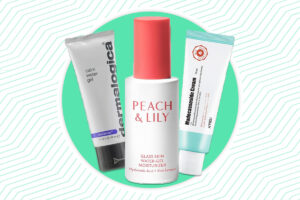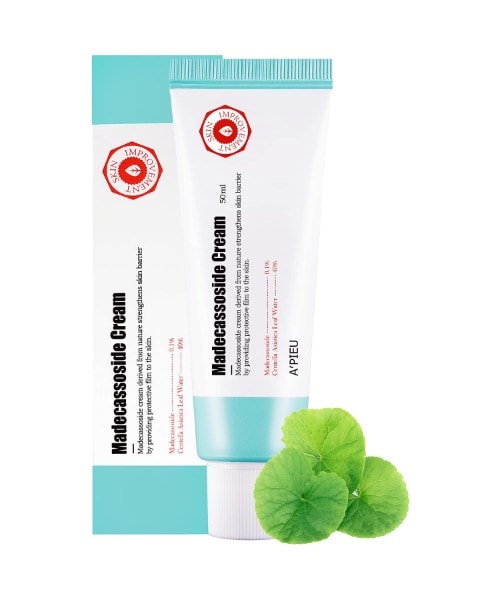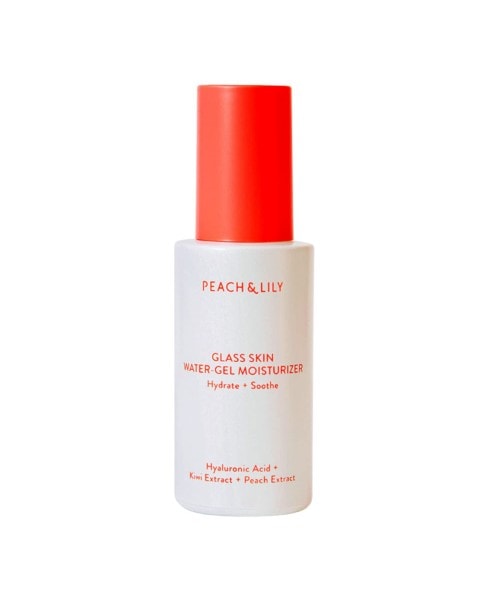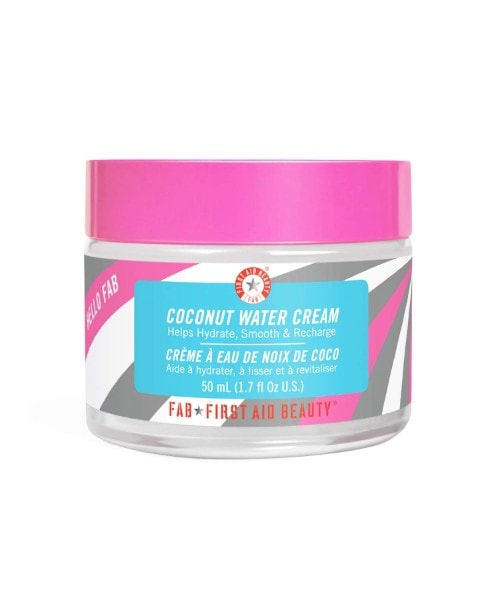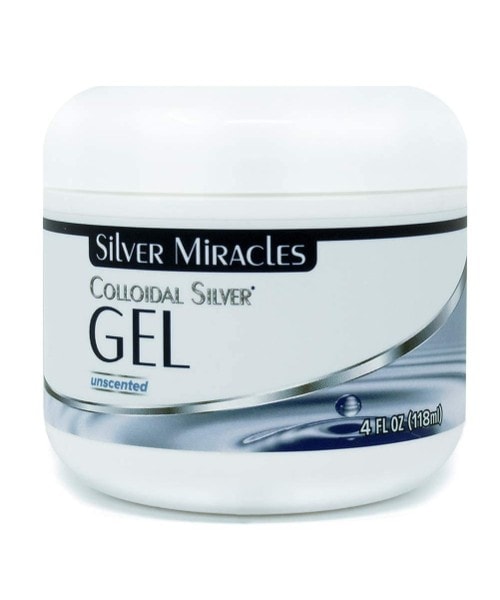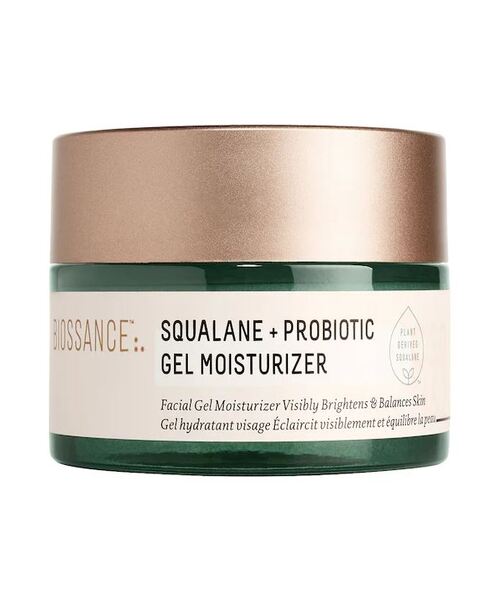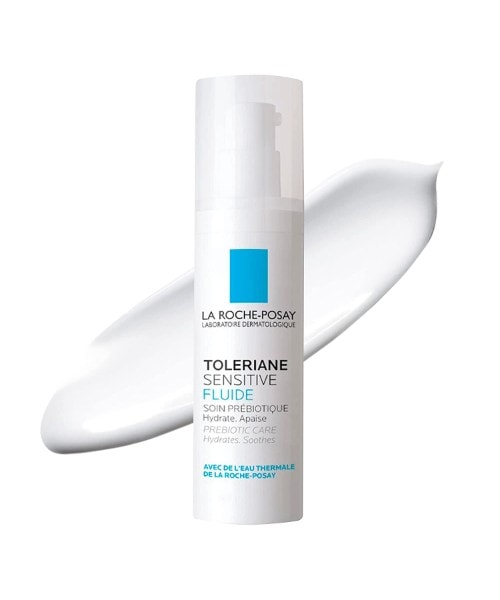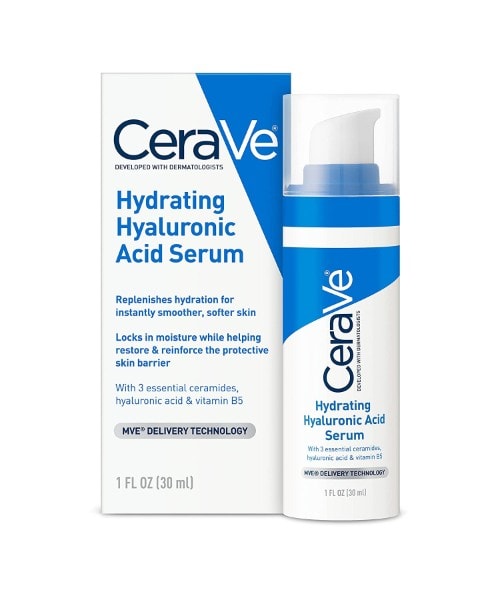The severity of your fungal acne is highly dependent on the skincare products you use, particularly moisturizers.
The best way to successfully clear fungal acne is to make sure you avoid products that allow Malassezia yeast grow and cause more inflammation on the skin. Sadly most skincare products on the market will lead to more redness, itchiness, and pustules if you are dealing with fungal acne.
Although the name makes fungal acne seem similar to “normal acne” the conditions are vastly different and require a completely different skincare routine. Fungal acne is a form of skin inflammation caused by an overgrowth of yeast on the skin while acne is primarily caused by clogged pores. Additionally, fungal acne is typically accompanied by dry skin, whereas normal acne is frequently present on oily skin.
A fungal acne safe moisturizer is extremely important for fungal acne because it is one of the few skincare products that can help restore the skin’s barrier, which is often damaged by the overgrowth of yeast on the skin.
The reason why fungal acne safe moisturizers are so difficult to find is that moisturizers often contain ingredients that feed the yeast and help it grow, even though that’s not their primary function but an unfortunate side effect of an overall helpful product.
So, if you have been having trouble finding a moisturizer that won’t exacerbate your fungal acne, you’ve come to the right place.
In this article, you will find a list of the ten best moisturizers for fungal acne, reviewed by a licensed esthetician.
And without any further ado, let’s jump right into it.
How I reviewed each moisturizer for fungal acne safety
There are a few things that I took into consideration while reviewing each moisturizer on this list, including:
- Does the moisturizer contain any fungal acne triggers?
- How well does each moisturizer hydrate the skin?
- What skin type would benefit from each moisturizer most?
First and foremost, I looked at the ingredients list of each moisturizer to see if it contains any fungal acne triggers.
For those of you who don’t know, fungal acne triggers are ingredients that have been shown to cause or exacerbate fungal acne in some cases.
These include but are not limited to:
- Oils
- Waxes
- Emollients
- Stearates
- Butters
- Silicones
I also looked at the ingredients list to see if each moisturizer contains anti-fungal or anti-yeast ingredients, which include:
- Ceramides
- Capric/Caprylic Triglycerides
- Propylene Glycol
- Niacinamide
- Zinc
- Glycerin
- Colloidal Silver
- Urea
Next, I took into consideration how well each moisturizer hydrates the skin.
This is important because fungal acne is often caused or exacerbated by a compromised skin barrier, which can be further harmed by over-washing and using harsh, drying, and stripping products.
So, it’s essential to use a moisturizer that will help restore the skin’s barrier and prevent further damage.
Finally, I looked at each moisturizer and decided what skin type would benefit from it the most.
For example, some moisturizers are better suited for dry skin, while others are better for oily skin.
Some are better for sensitive skin, while others are better for coarser or more resilient skin.
So, depending on your skin type, you may want to choose a different moisturizer from the ones on this list.
I also made sure to explain my experience with each of the products listed, as well as what I liked or didn’t like, respectively.
Lastly, I also did thorough research on various websites, reading reviews from users and their experience with using each product.
So, with all that said, here are the ten best moisturizers for fungal acne:
The key to clearing up fungal acne lies in healing the skin barrier. The right moisturizer will help restore the ph balance of the skin, without clogging pores with heavy oils. This is why many products containing glycerin, zinc & ceramides typically see more success than thick emollients or butters.
Dr. Anna Chacon
Best Moisturizers for Fungal Acne
| Best | Moisturizer |
|---|---|
| Overall Jump to Review | Dermalogica – Calm Water Gel |
| On a Budget Jump to Review | A’pieu – Madecassoside Cream |
| Glycerin-Based Moisturizer Jump to Review | Peach & Lily – Glass Skin Water Gel Moisturizer |
| Glycerin-Free Moisturizer Jump to Review | First Aid Beauty – Hello FAB Coconut Water Cream |
| Natural Moisturizer Jump to Review | Benton – Aloe Propolis Soothing Gel |
| Urea Moisturizer Jump to Review | Silver Miracles – Colloidal Silver Gel |
| Squalane Oil Moisturizer Jump to Review | Biossance – Squalane + Probiotic Gel Moisturizer |
| Oil-Free Moisturizer Jump to Review | La Roche Posay – Toleriane Sensitive Fluide |
| Moisturizer for Dry Skin & Fungal Acne Jump to Review | DrFormulas – Niacinamide Zinc PCA Serum Moisturizer |
| Cerave Moisturizer Jump to Review | CeraVe – Hydrating Hyaluronic Acid Serum |
Best Overall:
Dermalogica – Calm Water Gel
Dermalogica’s gel has a cloudy consistency that’s somewhat gooey and reminds me of raw aloe vera gel, but with a few added benefits and a minimized risk of an allergic reaction, which is the main issue when using raw ingredients straight from a plant.
GoodGlow Score
Skin Type
Works best with oily, dry, normal, combination, and sensitive skin types.
Quick Absorption
Dermalogica’s gel based cleanser absobs into the skin instantly and does not leave any traces or residue.
Anti-Inflammatory
The combination of apple extract, cactus pear, hylauronic acid, and glycerin will help calm external skin inflammation.
Ingredient Callouts
Hyaluronic acid and cactus pear extract immediately hydrate and soothe dry skin.
Water/Aqua/Eau, Glycerin, Aloe Barbadensis (Aloe) Leaf Juice, Dimethicone, Butylene Glycol, Pyrus Malus (Apple) Fruit Extract, 1,2-Hexanediol, Diethylhexyl Carbonate, Opuntia Ficus-Indica Stem Extract, Sodium Hyaluronate, Dipotassium Glycyrrhizate, Hydrolyzed Sodium Hyaluronate, Lavandula Angustifolia (Lavender) Flower Extract, Stearyl Heptanoate, Cetyl PEG/PPG-10/1 Dimethicone, Hydroxyacetophenone, Sea Salt, Dimethicone Crosspolymer, Stearyl Caprylate, Lauryl PEG-9 Polydimethylsiloxyethyl Dimethicone, Potassium Sorbate, Citric Acid, Sodium Benzoate, Disodium Phosphate, Linalool,* Limonene.*
Dermalogica Calm Water Gel is a lightweight moisturizer formulated with sensitive skin in mind. The texture of the Calm Water Gel is truly unique, and while gel-like at first, it basically turns to a watery emollience when applied to the skin.
This is why the directed use is to activate this moisturizer by gently rubbing it between your fingertips and then pressing it into the skin.
Now, right off the bat, and judging by the consistency, the Calm Water Gel is definitely a suitable option for those whose skin is on the combo to oily side. It’s also suitable for normal to dry skin, but ultra dry skins will likely need to follow it up with something richer.
As for the ingredients, the Calm Water Gel contains antioxidants such as apple fruit extract, hydrating hyaluronic acid, and glycerin, as well as cactus pear, which is a soothing ingredient that helps calm inflammation on the skin.
All in all, I found this moisturizer good enough for my oily and acne-prone skin, and although it doesn’t contain ingredients that directly work on minimizing fungal acne, it’s important that it soothes inflammation and doesn’t exacerbate the issue in the process.
Dermalogica Calm Water Gel Pros:
- Soothing and hydrating.
- Excellent for oily and acne-prone skin.
- Can be used as a serum for dry skin.
Dermalogica Calm Water Gel Cons:
- Pricey.
Best On a Budget (for the money):
A’pieu – Madecassoside Cream
A’pieu’s Madecassoside cream absorbs fairly quickly, leaving a subtle glow behind. Due to its texture and finish, this moisturizer will be perfect for those with normal, combo, dry, or dehydrated skin who are dealing with irritations due to a compromised skin barrier.
GoodGlow Score
Skin Type
Works best with normal and dry skin types.
Restores Natural Skin Barrier
A’pieu contains niacinamide and hyaluronic acid which help restore and heal damaged skin barriers.
Natural Product
A’pieu is predominantly made up of plant based ingredients.
Ingredient Callouts
A’pieu contains the antioxidant Madecassoside which soothes the skin and decreases inflammation.
Centella Asiatica Leaf Water, Water(Aqua), Cyclopentasiloxane, Propanediol, Phenyl Trimethicone, Glycerin, PEG-10 Dimethicone, Niacinamide, Cyclohexasiloxane, Panthenol, Ethoxydiglycol, Disteardimonium Hectorite, Sodium Chloride, Rubus Suavissimus (Raspberry) Leaf Extract, Centella Asiatica Extract, Caprylyl Glycol, Pinus Densiflora Leaf Extract, Hamamelis Virginiana (Witch Hazel) Leaf Extract, Dimethicone Crosspolymer, Camellia Sinensis Leaf Extract, Butylene Glycol, Madecassoside, Pentylene Glycol, Caprylhydroxamic Acid, Adenosine, Lactic Acid, Sodium Lactate, Urea, Serine, Disodium EDTA, Sorbitol, Citrus Grandis (Grapefruit) Peel Oil, Asiaticoside, Citrus Limon (Lemon) Peel Oil, Pelargonium Graveolens Flower Oil, Lavandula Hybrida Oil, Juniperus Mexicana Oil, Citrus Nobilis (Mandarin Orange) Peel Oil, Allantoin, Chlorphenesin, Phenoxyethanol
A’pieu Madecassoside Cream is an ultra-hydrating moisturizer that helps soothe irritation and repair the skin barrier.
Coming out of the tube, the Madecassoside Cream appears to be a medium-weight lotion. However, as you begin to massage it into the skin, you will immediately feel how rich and soothing it is.
As for the ingredients, the main active ingredient inside the Madecassoside Cream is madecassoside, which is one of the main biologically active components of the famous Centella Asiatica.
Madecassoside has well-established wound healing, skin soothing, and antioxidant properties.
It’s also a known melanin inhibitor and can help even out the skin tone and improve discoloration such as dark spots left from acne and hormonal conditions such as melasma.
Additionally, the moisturizer also contains niacinamide, which is another brightening agent, as well as hyaluronic acid and glycerin for hydration, and a blend of plant-derived oils to help nourish the skin.
Lastly, the Madecassoside Cream also contains urea, which is definitely one of the best ingredients for fungal acne due to its ability to break down sebum and dead skin cells that can clog pores and lead to fungal overgrowth.
All in all, I found this moisturizer to be an excellent choice for those dealing with fungal acne as it’s hydrating, soothing, and full of ingredients that will help repair the skin barrier and bring its function back to normal.
Many will also appreciate the budget-friendly price tag, besides all the goodness this product has to offer!
A’pieu Madecassoside Cream Pros:
- Soothing and repairing.
- Excellent for dry and dehydrated skin.
- Affordable.
A’pieu Madecassoside Cream Cons:
- Oily skins might find it a bit too rich.
Best Glycerin-Based Moisturizer for Fungal Acne:
Peach & Lily – Glass Skin Water Gel Moisturizer
Peach & Lily’s Water Gel Moisturizer has a matte finish that will work best for those with excessively oily and acne-prone skin, and although it’s also good for normal to dry skin types, those on the drier side will likely need a heavier cream to follow it up.
GoodGlow Score
Skin Type
Works well with oily, dry, combination, and normal skin types.
Prevents Yeast Growth
High glycerin concentration prevents yeast from developing.
Plant Based
Peach & Lily’s Gel Moisturizer is 100% certified vegan.
Ingredient Callouts
Completely free of fragrances and alcohol.
Water (Aqua), Glycerin, Propanediol, 1,2-Hexanediol, Calendula Officinalis Flower Water, Sodium Hyaluronate, Hydrolyzed Hyaluronic Acid, Actinidia Chinensis (Kiwi) Fruit Extract, Prunus Persica (Peach) Fruit Extract, Anthemis Nobilis (Chamomile) Flower Water, Bambusa Textilis (Bamboo) Stem Extract, Arctium Lappa (Burdock) Root Extract, Morus Alba (Mulberry) Leaf Extract, Morus Alba Fruit Extract, Leuconostoc/Radish Root Ferment Filtrate, Apium Graveolens (Celery) Extract, Lactobacillus Ferment, Beta-Glucan, Fructooligosaccharides, Glycyrrhiza Glabra (Licorice) Root Extract, Sodium Acetylated Hyaluronate, Myrciaria Dubia Fruit Extract, Ganoderma Lucidum (Mushroom) Extract, Butylene Glycol, Melia Azadirachta Leaf Extract, Melia Azadirachta Flower Extract, Adenosine, Trisodium Ethylenediamine Disuccinate, Carbomer, Ethylhexylglycerin, Morus Alba Twig Extract, Morus Alba Bark Extract, Tromethamine, Xylose, Tocopherol.
Peach & Lily Glass Skin Water Gel Moisturizer is a refreshing gel moisturizer that’s packed with skin-loving ingredients to help soothe, hydrate, rebalance, and replenish the skin.
The first thing you’ll notice about this moisturizer is its light, watery, serum-like texture that immediately absorbs into the skin without leaving any sticky or tacky residue behind.
The Glass Skin Water Gel Moisturizer contains fantastic ingredients, including hydrating glycerin and hyaluronic acid complex, antioxidant kiwi extract, barrier-repairing peach extract, and soothing and replenishing licorice extract.
Additionally, the moisturizer also contains a prebiotic and probiotic complex, which consist of ingredients that specifically focus on nourishing and supporting the skin’s microbiome (the world of microorganisms residing on our skin.)
And this is important for those dealing with fungal acne since this condition usually results from an imbalance (overgrowth) of yeast on our skin.
Therefore, using a product with probiotic and prebiotic ingredients will help rebalance the skin’s microbiome and, in turn, help clear up fungal acne.
Lastly, the Glass Skin Water Gel Moisturizer is free of fragrance and drying alcohol, making it suitable for those with sensitive and reactive skin.
Peach & Lily Glass Skin Water Gel Moisturizer Pros:
- Lightweight and hydrating.
- Matte finish.
- Suitable for oily skin and fungal acne.
Peach & Lily Glass Skin Water Gel Moisturizer Cons:
- Pricey.
- Dry skins won’t find it hydrating enough.
Best Glycerin-Free Moisturizer for Fungal Acne:
First Aid Beauty – Hello FAB Coconut Water Cream
If you are looking for a glycerin-free moisturizer for fungal acne, look no further than First Aid Beauty’s Hello FAB Coconut Water Cream, a lightweight hydrator that’s excellent for all skin types and inflammatory conditions.
GoodGlow Score
Skin Type
Works best with oily and normal skin.
Certified Vegan
First Aid’s coconut water cream is 100% certified vegan.
Non-Comedogenic
Made with 100% non-comedogenic ingredients.
Ingredient Callouts
Free of most popular allergens including soy, gluten, nuts, and oil.
Cocos Nucifera (Coconut) Fruit Juice, Glucose, Maltodextrin, Aqua (Water, Eau), Dimethicone, Sodium Acrylate/Sodium Acryloyldimethyl Taurate Copolymer, Cocos Nucifera (Coconut) Fruit Extract, Sodium Hyaluronate, Alteromonas Ferment Filtrate, Pyrus Malus (Apple) Fruit Extract, Prunus Armeniaca (Apricot) Fruit Extract, Vanilla Planifolia Fruit Extract, Sea Salt (Maris Sal, Sal Marin), Lycium Barbarum Fruit Extract, Glycyrrhiza Glabra (Licorice) Root Extract, Chrysanthe-mum Parthenium (Feverfew) Extract, Camellia Sinensis Leaf Extract, Dipteryx Odorata Seed Extract, Coffea Arabica (Coffee) Seed Extract, Tocopherol, Caprylyl Glycol, Caprylic/Capric Tri-glyceride, Butylene Glycol, Hydrogenated Polydecene, Dipropylene Glycol, Cetyl Diglyceryl Tris(Trimethylsiloxy)silylethyl Dimethicone, Polysilicone-11, Laureth-8, Phenoxyethanol.
Glycerin is an excellent ingredient in skincare products, especially loved by its ability to attract and retain moisture in the skin.
However, although stable, non-toxic, and usually non-irritating, glycerin allergies, although rare, are experienced by some people, which can make the process of finding a good moisturizer incredibly challenging.
But luckily, that isn’t the case with the Hello FAB Coconut Water Cream, as this moisturizer isn’t only glycerin-free but is also packed with soothing, hydrating, and skin-repairing ingredients, such as hyaluronic acid and coconut water.
Additionally, the moisturizer also contains Alteromonas Ferment Filtrate, a so-called exopolysaccharide (a naturally big molecule secreted by microorganisms) coming from marine bacteria living in French Polynesia.
The manufacturer of this particular ingredient claims that it can stimulate the production of hyaluronic acid, lipids, and filaggrin in the skin, which are all important skin components that help the skin regenerate and retain moisture and improve the barrier’s function.
Marissa, one of our product testers who dealt with fungal acne, had this to say about Hello Fab:
The reason why I love the Hello FAB Coconut Water Cream is that it’s a perfect summer moisturizer for my oily and acne-prone skin, and if you are in the same boat, you probably know how challenging it is for us to find something that won’t make us look like a greaseball in the scorching heat.
Marissa, Product Tester
Additionally, the moisturizer doesn’t contain a single potentially clogging ingredient that can serve as food for the yeast causing fungal acne, making it a perfect solution for someone who is dealing with this condition.
First Aid Beauty Hello FAB Coconut Water Cream Pros:
- Soothing, hydrating, and skin-repairing properties.
- Excellent for oily skin and fungal acne.
- Great summer moisturizer for dry and dehydrated skin.
First Aid Beauty Hello FAB Coconut Water Cream Cons:
- Some might find it expensive.
Best Natural Moisturizer for Fungal Acne:
Benton – Aloe Propolis Soothing Gel
Benton’s Aloe Propolisgel has a slightly mattifying texture, making it a perfect option for those with combo and oily skin who are dealing with fungal acne in certain areas. It works especially well as a moisturizer in the summer due to its aloe content.
GoodGlow Score
Skin Type
Works best with oily, dry, sensitive, and combination skin.
Certified Vegan
All of Benton’s products are 100% certified vegan.
Prevents Yeast Growth
Acidic base prevents yeast growth on the skin.
Ingredient Callouts
Contains active ingredients aloe vera, vitamin B, and vitamin C to help soothe the moisture vbarrier of the skin.
Aloe Barbadensis Leaf Water, Butylene Glycol, Aqua (Water), Pentylene Glycol, 1,2-Hexanediol, Glycerin, Propolis Extract, Aloe Barbadensis Leaf Extract, Betaine, Cucumis Sativus (Cucumber) Fruit Extract, Portulaca Oleracea Extract, Camellia Sinensis Leaf Extract, Allantoin, Aloe Barbadensis Leaf Juice Powder, Zanthoxylum Piperitum Fruit Extract, Pulsatilla Koreana Extract, Usnea Barbata (Lichen) Extract, Acrylates/C10-30 Alkyl Acrylate Crosspolymer, Arginine
Benton Aloe Propolis Soothing Gel is a soothing gel moisturizer that’s super lightweight, extremely gentle, and suitable for all skin types and inflammatory conditions.
The main active ingredient in this gel is aloe vera, which is a known soothing agent that contains antioxidants such as vitamins B and C and has antibacterial properties that help relieve inflammation caused by bacteria overgrowth.
Additionally, the Soothing Gel also contains propolis, a resinous mixture with antibacterial and anti-inflammatory as well as emollient properties that promote wound healing and skin nourishment.
The transparent and gellish texture spreads on the skin with ease; however, one thing to pay attention to is not to use this gel on dry skin, as this will likely cause more dryness than benefits.
Instead, apply a pea-sized amount while your skin is still damp after cleansing or after a previous step in your skincare regimen, such as a toner or a serum.
This way, the Soothing Gel will work for your skin and actually provide beneficial effects, instead of just sitting on top of the skin and being sticky and drying.
I like to use the Soothing Gel as a last step in my morning skincare regimen (15-20 minutes before applying sunscreen) and give it some time to work before following up with my makeup.
It’s also great for soothing sunburns, but it’s always better to avoid these in the first place by protecting your skin with high SPF.
Benton Aloe Propolis Soothing Gel Pros:
- Lightweight and hydrating.
- Excellent for combo, oily, and acne-prone skin.
- Extremely soothing.
- It can be used to relieve discomfort due to sunburn.
Benton Aloe Propolis Soothing Gel Cons:
- Can be drying if used incorrectly.
Best Urea Moisturizer for Fungal Acne:
Silver Miracles – Colloidal Silver Gel
The Silver Miracles Colloidal Silver Gel is the best moisturizer for dry, itchy skin dealing with inflammatory conditions such as eczema, psoriasis, rashes, sunburns, as well as fungal and bacterial acne.
GoodGlow Score
Skin Type
Works well with all skin types.
Penetrates Skin Barrier
Colloidal Silver Gel ‘s molecules are able to easily penetrate the skin barrier and immediately deliver nutrients.
Balances Skin PH
Urea content helps balance skin PH, which prevents bacteria growth.
Ingredient Callouts
No added colors, fragrances, or alcohols.
Water (Type 1 Ultrapure), Sodium Carbomer, Urea, Argentum Metallicum (Colloidal Silver)
Silver miracles Colloidal Silver Gel has a lightweight yet slightly thicker texture that’s easy to apply and spread on the skin.
It also has an instant soothing effect, which is something I personally loved most about trying this product.
The main active ingredient in this gel is colloidal silver, which are tiny pieces of silver suspended in a water solution.
As the molecules are small, they are able to penetrate the skin easily and absorb instantly, meaning your skin receives the best of its properties.
Colloidal silver is a natural antibiotic known for its antibacterial, anti-inflammatory, and healing properties, making it an exceptionally good ingredient for those dealing with inflammation and acne.
Additionally, the gel also contains urea, a compound naturally present in the skin and helps with moisture retention.
Urea is a natural moisturizing factor, also known as NMF, which are important components that help the skin hold onto water and keep it plump, hydrated, and elastic.
Urea makes up for about 7% of NMFs next to other significant components such as amino acids, PCA, and Lactate.
But what makes it special is that this small molecule, which is a regulator of the epidermal structure and function, offers many extra biological activities for the skin.
It acts as a keratolytic agent to break down bonds in the protein called filaggrin, which will lead to freeing up amino acids in the skin, enhancing the activity of antimicrobial peptides, and improving the skin barrier function.
Urea is also exceptionally good for those struggling with fungal acne, as it helps to balance the skin’s pH levels, making it less hospitable for fungal growth.
What’s also great about the Colloidal Silver Gel is that it only has four ingredients, making it a safe option for all skin types, including ultra-sensitive skin, due to being unlikely to cause irritation like some skincare products with a more comprehensive ingredient list.
Silver Miracles Colloidal Silver Gel Pros:
- Short and simple ingredient list.
- Soothing and skin-repairing.
- Excellent for all skin types and inflammatory conditions.
Silver Miracles Colloidal Silver Gel Cons:
- Some users think the packaging is outdated and that a pump bottle would be better and more hygienic.
Best Squalane Oil Moisturizer for Fungal Acne:
Biossance – Squalane + Probiotic Gel Moisturizer
Biossance’s Squalene Oil Moisturizer contains a nice blend of humectants, ceramides, and emollients to hydrate, soothe, and repair a compromised skin barrier.
GoodGlow Score
Skin Type
Works best with dry and normal skin types.
Restores Natural Skin Barrier
Combination of humectants, ceramides, and emollients help repair and soothe damaged skin barriers.
Keeps Skin Moisturized
Biossance’s thick gel keeps moisture from leaving the skin.
Ingredient Callouts
The Squalane + Probiotic Gel Moisturizer is a fungal safe probiotic mix that nourishes the skin without allowing harmful bacteria to grow.
Water/Aqua, Squalane, Glycerin, Dimethicone, Pentylene Glycol, Ammonium Acryloyldimethyltaurate/VP Copolymer, Lactococcus Ferment Lysate, Caprylic/Capric Triglyceride, Phenoxyethanol, Caprylyl Glycol, Dimethiconol, Chrondrus Crispus Extract, Allantoin, Bisabolol, Glycine Soja (Soybean) Sterols, Linoleic Acid, Phospholipids, Sodium Phytate, Lechithin, Sodium Hydroxide, Sodium Hyaluronate, Lactic Acid, Lepidium Sativum Sprout Extract, Sodium Chloride, Sodium Benzoate, Citric Acid, Zingiber Officinale (Ginger) Root Extract
Biossance Squalane + Probiotic Gel Moisturizer is an excellent moisturizer that contains ingredients to help hydrate and replenish the skin while soothing existing redness, inflammation, and conditions such as acne.
The Squalane + Probiotic Gel Moisturizer has a gel-to-cream consistency that’s definitely on the richer side but also feels silky and pleasant when applied to the skin.
One of my favorite ingredients in the Squalane + Probiotic Gel Moisturizer is linoleic acid, a famous omega-6 fatty acid with a particular structure that makes it super-emollient yet thinner than most standard emollients found in skincare products.
Linoleic acid serves as a structural precursor for the most important skin lipids called ceramides; thus, it has a central role in the structure and function of a healthy skin barrier.
Deficiency in this particular component can lead to a more permeable skin barrier that’s unable to perform its function and prevent moisture from evaporating, leaving the skin dry, irritated, and unable to protect itself from pathogens.
However, with all the goodness said, I must mention that this product is definitely on the thicker side compared to some others on this list, and as someone with very oily and extremely acne-prone skin, I was only able to enjoy the Squalane + Probiotic Gel Moisturizer during winter and as a part of my evening routine.
That said, during this time, I noticed a massive improvement in my skin, noticing signs like plumpness, glow, and tighter-looking pores due to the stabilized sebum production, thanks to linoleic acid.
The Squalane + Probiotic Gel Moisturizer is also safe for fungal acne due to the probiotic complex that balances and protects the skin microbiome.
Biossance Squalane + Probiotic Gel Moisturizer Pros:
- Provides a beautiful glow.
- Balances and protects the skin microbiome.
- Improves the skin barrier function and protects the skin from pathogens.
Biossance Squalane + Probiotic Gel Moisturizer Cons:
- It can be too thick for oily skin in summer.
Best Oil-Free Moisturizer for Fungal Acne:
La Roche Posay – Toleriane Sensitive Fluide
La Roche Posay’s Tolarine sensitive fluide is formulated with only ten ingredients, including water, caprylic/capric triglyceride, which are lipids essential for skin’s health, soothing propanediol, brightening and balancing niacinamide, and a few other humectants and stabilizers.
GoodGlow Score
Skin Type
Works best with oily, normal and combination skin.
Non-Comedogenic
LA Roche’s moisturizer does not contain any comedognic ingredients which make it a great fit for any type of acne.
Recommeded By Dermatologists
LA Roche’s moisturizer is recommended by Dermatologists worldwide for treating fungal acne, rosacea, and eczema
Ingredient Callouts
Glycerin content makes it difficult for fungal acne to grow and spread.
AQUA /WATER / EAU, CAPRYLIC/CAPRIC TRIGLYCERIDE, GLYCERIN, PROPANEDIOL, PENTYLENE GLYCOL, NIACINAMIDE, AMMONIUM POLYACRYLOYLDIMETHYLTAURATE, CAPRYLYL GLYCOL, CITRIC ACID, XANTHAN GUM.
The La Roche Posay Toleriane Sensitive Fluide is my favorite moisturizer that I would recommend to anyone whose skin is super oily and very acne-prone.
And I say “very acne-prone” because there are skins that get clogged from super heavy oils such as coconut oil (which is very normal), but there are also those that get clogged and break out from ingredients that are found in many products marketed towards acne-prone skin.
The Toleriane Sensitive Fluide is definitely a great option for the latter category, as this moisturizer or a lightweight emulsion is specially formulated for the extra problematic skin that doesn’t handle any type of oil or butter very well.
It also contains a high concentration of glycerin and is safe for fungal acne, which is yet another problem commonly triggered by many skincare products marketed toward acne-prone skin.
And lastly, the Toleriane Sensitive Fluide is exceptionally good for ultra-sensitive and reactive skin as well as conditions such as rosacea and eczema. It’s formulated without irritating fragrance or fragrant components, and it doesn’t contain drying alcohols, either.
One tip for making the most out of this product is to apply it on damp skin, as this allows the emulsion to spread easier and last longer, and you will need to use less product for the entire face.
La Roche Posay Toleriane Sensitive Fluide Pros:
- Gentle, soothing, and suitable for sensitive and reactive skin.
- Excellent for skin that’s extremely prone to clogging and acne.
- Safe for fungal acne.
- It has a silky finish and gives a subtle glow.
La Roche Posay Toleriane Sensitive Fluide Cons:
- Some users have complained about the bottle’s small size (1.3 oz).
Best Moisturizer for Dry Skin & Fungal Acne:
DrFormulas – Niacinamide Zinc PCA Serum Moisturizer
DrFormula’s Niacinamide serum contains hyaluronic acid and glycerin, which are humectants that help the skin retain moisture, as well as aloe vera leaf juice, which is a soothing and antibacterial agent.
GoodGlow Score
Skin Type
Works best with dry skin.
Reduces Sebum Oil Production
High niacinamide content helps clear out excess sebum oil.
Recommeded By Dermatologists
DrFormula’s products were developed and designed by dermatologists.
Ingredient Callouts
100% silicone, fragrance, and alcohol free
zinc PCA aloe vera, hyaluronic acid, squalane, niacinamide.
DrFormulas Niacinamide Zinc PCA Serum Moisturizer is one of the few products that I have tried and loved from this brand.
The Niacinamide Zinc PCA Serum Moisturizer comes in a pump bottle that dispenses a thicker serum that can be used on its own or followed up with a moisturizer for someone with ultra-dry skin.
The product contains niacinamide, which is a form of vitamin B3, and zinc PCA, which are both known to be effective in reducing sebum production, brightening the skin, and improving the appearance of acne scars.
Lastly, the Niacinamide Zinc PCA Serum also contains triglycerides and squalane, both naturally found in our sebum and vital components for a healthy and functioning skin barrier.
Once applied to the skin, the serum will glide across the surface with ease and absorb within seconds of application, leaving a silky smooth canvas behind while immediately getting to work to reduce the overgrowth of yeast that’s causing fungal acne.
And lastly, which is something I appreciate the most, is that the Niacinamide Zinc PCA Serum can be used at any time of the year, which is something that not many other products do, especially for oily folks who usually require different moisturizers in summer and winter.
DrFormulas Niacinamide Zinc PCA Serum Moisturizer Pros:
- Soothing and antioxidant ingredients work to nourish the skin and improve barrier function.
- Suitable for all skin types.
- Great for fungal and bacterial acne.
DrFormulas Niacinamide Zinc PCA Serum Moisturizer Cons:
- Not easily available for users outside of the US.
Best Cerave Moisturizer for Fungal Acne:
CeraVe – Hydrating Hyaluronic Acid Serum
CeraVe’s Hydrating Hyaluronic Acid Serum contains 3% hyaluronic acid, which is a humectant that can hold up to 1000x its weight in water, making it an extremely effective ingredient in replenishing the skin’s moisture levels. Besides that, the formula also contains niacinamide and glycerin, which are great ingredients that help support a healthy and functioning skin barrier.
GoodGlow Score
Skin Type
Works well with oily, dry, normal, and dehydrated skin types.
Keeps Skin Moisturized
Hyaluronic Acid Serum keeps skin barrier moisturized and protected.
Recommeded By Dermatologists
All of CeraVe’s products are designed, tested, and recommended by dermatologists.
Ingredient Callouts
100% paraben and fragrance free.
AQUA/WATER/EAU, GLYCERIN, CETEARYL ETHYLHEXANOATE, DIMETHICONE, AMMONIUM POLYACRYLOYLDIMETHYL TAURATE, SODIUM HYALURONATE, PANTHENOL, CERAMIDE NP, CERAMIDE AP, CERAMIDE EOP, CARBOMER, CETEARYL ALCOHOL, BEHENTRIMONIUM METHOSULFATE, SODIUM HYDROXIDE, SODIUM LAUROYL LACTYLATE, CHOLESTEROL, PHENOXYETHANOL, DISODIUM EDTA, ISOPROPYL MYRISTATE, CAPRYLYL GLYCOL, CITRIC ACID, XANTHAN GUM, PHYTOSPHINGOSINE, ETHYLHEXYLGLYCERIN (CODE F.I.L. D241438/2)
CeraVe Hydrating Hyaluronic Acid Serum is a must-have for anyone dealing with fungal acne and is looking for a lightweight product that won’t exacerbate this inflammatory condition.
Last, and my personal favorite ingredient in the Hydrating Hyaluronic Acid Serum are ceramides, which make up 50% of the composition of our skin barrier, and they play an essential role in keeping the skin hydrated and protected from environmental aggressors.
Ceramides are also super important for our skin microbiome, which, when imbalanced, can lead to conditions such as fungal acne.
And now, let’s move on to the elephant in the room, which is why I added the Hydrating Hyaluronic Acid Serum to this list of best moisturizers for acne.
It’s because, having used this product, I can say that it’s on the thicker side for a serum, and people with very oily or dehydrated skin may very well use it as a moisturizer if it works better that way.
On the other hand, dry skin folks will likely need something heavier to follow it up with, but it wouldn’t come as a surprise if some find it enough on its own.
Unless a serum has a very lightweight consistency that’s drying out your skin and definitely need to be followed up with a moisturizer, you can feel free to experiment with skincare products and use them in a way that works best for you and not necessarily how they are intended to be used.
CeraVe Hydrating Hyaluronic Acid Serum pros:
- Excellent for all skin types.
- It can be used as a moisturizer.
- Safe for fungal acne.
CeraVe Hydrating Hyaluronic Acid Serum Cons:
- None.
What happens to fungal acne if you do not moisturize your skin?
When you’re experiencing fungal acne, your skin in the affected areas usually looks oily and feels greasy and heavy.
Therefore, the logical thing to do is not to use a moisturizer in these areas, as it will only add more oil and grease.
However, not moisturizing your skin when experiencing fungal acne could be a mistake, as the lack of hydration can have serious consequences.
Without using any hydrating products, your skin might become too dry and irritated, leading to an increase in oil production, which is the skin’s way of compensating for dryness.
Additionally, moisturizing your skin is essential for maintaining a healthy skin barrier, which is often compromised by the overgrowth of yeast on the skin, resulting in inflammatory conditions such as fungal acne.
However, not every moisturizer will work for fungal acne, and some may easily exacerbate the condition.
Therefore, when choosing a moisturizer that’s safe for fungal acne and won’t exacerbate the condition, you need to consider the three main components that make up a moisturizer: humectants, emollients, and occlusives, as some of these are suitable for fungal acne and some are not.
Humectants & fungal acne
Humectants are hygroscopic components that attract and hold onto water and are used in skincare products to attract moisture from the environment or the deeper layers of the skin and bind it to the surface.
Humectants can be beneficial when dealing with fungal acne as they can visibly smooth out the bumps while infusing the upper layers of the skin with moisture, which will help strengthen the skin barrier and reduce inflammation and redness.
Additionally, some humectants found in skincare products can also help control yeast overgrowth, which should help reduce the severity of fungal acne.
Some great humectants to look for when choosing a moisturizer for fungal acne include:
Glycerin
Glycerin is one of the most popular humectants on the skincare market and is found in almost every cosmetic product out there.
Known for its ability to attract and hold moisture, glycerin can help maintain smooth, healthy, and clear skin that’s balanced, which reduces the potential for yeast overgrowth.
Additionally, glycerin can also help reduce inflammation, which is another plus when using this component to treat fungal acne.
Hyaluronic acid
Another common humectant found in many skincare products, including cleansers, toners, serums, moisturizers, and even sunscreens, hyaluronic acid is known for its ability to hold up to 1000 times its weight in water and can provide long-lasting hydration, which can help improve issues like dryness, irritation, uneven skin texture, and some inflammatory conditions like fungal acne.
Urea
Urea is a less common humectant used in skincare products, but not less beneficial when dealing with fungal acne.
Urea is known for its excellent hydrating properties and ability to gently exfoliate the skin and encourage the formation of new, healthy skin cells without causing irritation and peeling, which are side effects often associated with other exfoliating components.
Urea can also help reduce itching and flaking, both common symptoms of fungal acne, and help restore and strengthen the skin barrier.
Honey
Honey is not only an excellent humectant that hydrates the skin and slows down transepidermal moisture loss, but it also has antibacterial and antifungal properties and has been used for centuries to treat a variety of skin conditions, including fungal infections.
The antioxidants, enzymes, and nutrients found in honey can help reduce inflammation, redness, and itching associated with fungal acne and provide the skin with additional hydration and nourishment needed to recover from yeast colonization.
Emollients & fungal acne
Emollients are softening ingredients found in moisturizers whose purpose is to cover the skin with a protective layer to trap moisture and prevent it from evaporating through its surface.
While emollients aren’t always the problem, and they have a pretty important job in moisturizers, they can sometimes be irritating and greasy and can further worsen fungal acne symptoms if the wrong one is used.
Here are some common emollients found in moisturizers and how they could affect fungal acne:
Shea butter
Shea butter is a simple and effective natural emollient that regenerates and soothes the skin while protecting it from environmental aggressors.
Rich in antioxidants such as vitamins E, F, and epigallocatechin gallate, a soothing component also found in green tea, shea butter can help reduce inflammation, redness, and itching associated with fungal acne.
Panthenol
Panthenol is a combination of humectant and an emollient and is a lightweight component that does a great job of soothing, repairing, and relieving skin itches caused by irritants and the overgrowth of yeasts and bacteria.
Excellent for fungal acne, panthenol can help reduce the appearance of redness and irritation while providing moisture to the skin.
Propanediol
Another combination of humectants and emollients, propanediol is often added to skin-repairing balms and ointments due to its ability to penetrate the skin quickly and deeply, boosting hydration.
Propanediol also has antifungal and soothing properties, making it an excellent choice for treating fungal acne.
Caprylic/Capric triglycerides
Another common emollient in many skincare products is caprylic/capric triglycerides, which help create a protective barrier on the skin and reduce moisture loss.
Triglycerides are an essential component of our skin barrier, so when the barrier is compromised due to yeast overgrowth, adding this ingredient to your skincare routine can help reduce dryness and itchiness and restore the natural lipid balance of the skin, making it an excellent ingredient for treating fungal acne.
Occlusives & fungal acne
Occlusives are basically heavier emollients, and although excellent for relieving skin dryness, soothing irritation, and protecting a wound from becoming infected by external pathogens, they are not the option you want to go for when dealing with fungal acne.
These ingredients can be highly comedogenic and problematic for oily skin prone to developing acne and can exacerbate fungal infections if used in excess.
Some occlusive ingredients often added to moisturizers and ointments you should avoid if you’re dealing with fungal acne include:
Lanolin
A waxy substance secreted by the sebaceous glands of wool-bearing animals, lanolin is an ingredient often found in lip products, body lotions, and facial moisturizers targeted toward those with dry, parched, and irritated skin.
Lanolin creates a seal on the skin’s surface, which helps prevent transepidermal moisture loss, thus helping relieve skin dryness, but it is notoriously difficult to wash off and can also trap bacteria in the skin that can cause irritation after a while.
Lanolin can be especially problematic for those with fungal acne, as it can further clog the pores and worsen the infection by enabling yeast overgrowth.
Petrolatum
Petrolatum is the vegan counterpart of lanolin with the same function and effect on the skin.
Equally terrible for those with fungal acne, petrolatum should be steered clear of as the seal it creates on the skin, although helpful for softening it, can worsen certain skin conditions, including existing yeast infections.
Mineral oil
Mineral oil is a purified, colorless, odorless oil made from petroleum and is used in various beauty products to help soften the skin and reduce moisture loss.
However, mineral oil is also known to increase comedogenicity and can make existing fungal acne worse.
Additionally, mineral oil can also cause unwanted reactions in those with already sensitive skin, so it’s best to avoid it when dealing with fungal acne and a compromised skin barrier.
Cocoa butter
Cocoa butter is frequently found in nourishing moisturizers and lip products due to the high content of fatty acids, antioxidants, and polyphenols that help protect and nourish the skin.
However, although beneficial for those with excessively dry skin and chapped lips, cocoa butter is not the savior those dealing with fungal acne would hope it to be.
Cocoa butter is too heavy, and besides leaving a greasy feeling on the skin, it can also worsen the infection and cause further breakouts.
Fungal acne safe oils
While those dealing with fungal acne are generally advised to stay away from oils, as oily skin can partly be to blame for the condition developing in the first place, there are some oils that are gentle and can even improve this skin concern if used correctly and with caution.
Oils such as MCT, made from medium-chain triglycerides, are known to have antifungal properties besides nourishing the skin and helping strengthen the skin barrier, which will balance out sebum production and reduce the likelihood of developing fungal acne.
And while you should definitely be careful when introducing oils into your skincare routine, especially when trying to soothe fungal acne, some of these can produce satisfactory results in managing inflammatory skin conditions caused by yeast overgrowth.
What is the best skincare routine for fungal acne?
Fungal acne is less common than normal and bacterial acne but none less annoying, especially when you consider the fact that they look very similar to one another, except that fungal acne doesn’t respond to standard acne treatments.
It is, however, important to make sure that you have a good skincare routine that will help keep the skin clean, balanced, and protected, as this can help mitigate some of the symptoms.
Therefore, using a fungal acne-safe cleanser, moisturizer, and sunscreen is the first step in assembling a skincare routine of fungal acne safe products.
Additionally, if you use makeup daily, you should also make sure that the complexion products you are using don’t contain ingredients that could potentially exacerbate the condition and cause it to spread to other areas of the face.
Finally, introducing an antifungal agent such as ketoconazole, clotrimazole, or ciclopirox can also help reduce the overgrowth of yeast on the skin and minimize its symptoms. On the other hand, if the infection is too vast and stubborn, you can speak with your health provider and ask for antifungal medication such as fluconazole or itraconazole tablets that should help control the infection.
Overall, following a simple skincare routine and paying extra attention to the ingredients inside the products you are using can help keep fungal acne under control.
Frequently Asked Questions
Antimicrobial oils are best for treating skin with fungal acne. This includes glycerin, tea tree oil, and jojoba oil.
The worst ingredients for fungal acne are butters, emollients, waxes, and stearates.
